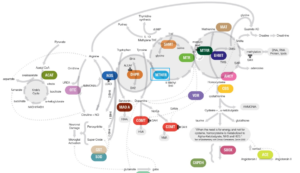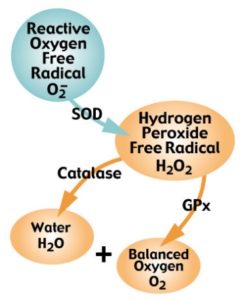Lecture 2: Biochemistry , enzymes
By Carina Stjernholm Hoff, Norway, 04.27.17, parent and educator
In this lecture the purpose is to give you a brief understanding of what biochemistry is, the role of enzymes and what they are, and why, as an educator, I feel targeted nutrition is important for our children in order to develop in an optimal way. My goal here is also to give a simplified understanding as to how complex biochemical reactions and pathways in the body truly are, but at the same time knowing that they can be affected in a positive way. In order to understand the role of enzymes in biochemical reactions, I have also included a brief explanation as to what enzymes are.
Biochemistry and the role of enzymes
Remember from my last lecture, that genes are located on chromosomes and are specific DNA that codes for proteins. One specific gene codes for one specific protein. The human genome has about 22,000 genes, which all codes for one particular protein. A lot of those proteins are enzymes. Your body is at every given time dependent on several thousand enzymes in order to function. This is because practically every chemical reaction that happens in your body is dependant upon the right enzyme to get the reaction going. This means that reactions what would never happen outside your body, is made possible because of the enzymes that aids this particular reaction. Biochemistry is therefore the description of the chemistry that happens inside the body. Almost all of these reactions will only happen because of that proper enzyme being present to make it happen. In every give second there are millions of chemical reactions happening in your body, in everything from you being able to use the oxygen you breathe, to digest the food you eat, for your body to create the energy it needs to work, and the list could go on and on. It is impossible to try to imagine all the different reactions that are taking place at the same time, and knowing that they would never happen if not for the right enzyme being present. In order to understand more about how the biochemistry works, you need to have a clearer picture of what an enzyme does.
What does an enzyme do?
An enzyme can be thought of as a key that fits into a substrate. Without this key, chemical reactions cannot take place. To explain this further, we can look at one specific enzyme, called lactase. This enzyme aids the reactions of dividing the milk sugar lactose into to the two sugars, glucose and galactose:

When you drink a lactose containing drink, like cow’s milk, your body needs to break down this lactose into glucose and galactose, in order to be able to absorb the sugar. If this doesn’t happen, the lactose will be food for the bacteria in your large intestines, resulting in bloating, diarrhea and stomach cramps. Your body needs the enzyme lactase to aid that biochemical reaction where the lactose is split up properly. The more milk you drink the more lactase the body requires. Lactase is an enzyme, and thus a protein, This particular protein is the product of the llactase gene located on chromosome 2. We all have two copies of this gene, one from your mum and one from dad. The reason why some people can tolerate lactose well, and others can’t, is therefore linked to their genes. As you might know, small children are more likely to tolerate lactose than adults. This example thus also illustrates the fact that genes and the copying of those genes into proteins, can be influenced throughout your lifetime. The enzyme lactase and its gene is one example out of several thousand genes and there resulting enzymes that works in the body at any given time. Even one error in one of these genes can potentially be devestating. In some cases, such as a group of diseases known as Leukodystrophries, an error can be fatal.
Biochemistry and its complicated pathways
All the biochemical reactions in the body are linked to each other, in one way or another. Only looking at these reactions separately is therefore just as seeing the tip of the iceberg. To illustrate this, we can look at the MTHFR gene and its product, the MTHFR enzyme. As we discussed in lecture 1, this enzyme is linked with the body’s ability to make folate that the body can use. As we discussed in this previous lecture, having a variation of this enzyme (a mutation) can lead to an enzyme that is much less efficient, leading to a folate deficiency in the body and possibly in the maturing egg cell. This one enzyme, the MTHFR, is just one piece in a very complex biochemical pathway, called the methyl pathway, in the human body. The reason for including this as an example, is to illustrate just how complex these pathways are. For us as parents, though, it is sufficient to understand that this is extremely complicated and that almost all biochemical reactions will impact several other reactions. The methyl pathway shown below are thus not something we will even try to understand, but it gives a picture of the complexity and the fact that there in this pathway are several other enzymes that are just as important as the MTHFR, including the CBS enzyme, which gene is located on chromosome 21 and over expressed in Down syndrome.

These types of pathways and interconnecting reactions are typical for all biochemical reactions in the body. Where one reaction can initiate ten other reactions, which in turn can affect hundreds and thousands of yet other biochemical reactions.
How extra genes affects the body’s biochemistry
As we know, our children have one extra copy of chromosome 21, leaving them with one extra copy (three instead of two) of all the genes on that chromosome. Chromosome number 21 has 225 genes. That means that this chromosome has the genetic code for making 225 proteins many of which are enzymes. The challenge for a body that has too many genes, is however different from having genes that are not working properly. Still, those extra genes will affect the biochemical pathways in the body, resulting in the challenges we know are common children and adults with Trisomy 21. Now that you know that just one mutated gene can be enough to alter the whole biochemical system in a body, it should be easy to understand that having three instead of two copies of genes, will do that as well.
Not all genes encoded on chromosome 21 in Down syndrome are active. Only those within an area on the short leg of the chromosome (called “P”) known as the DSCR or Down syndrome critical region are turned on. But this relatively small number of active genes disrupts the entire genome. One of the reasons is that three copies of a gene will result in too much of that protein being made. One  example is the SOD1 gene (superoxide dismutase) mapped to the DSCR. This is an enzyme that needs to work together with two another enzymes, catalase and glutathione peroxidase. The genes for these two enzymes, however, are not located on chromosome 21. That means that the body makes 1.5 times too much of the SOD1 protein, compared to the catalase and glutathione peroxidase. The uneven amounts of SOD1 and its co worker enzymes creates serious problems. This SOD1 gene is just one example, there are several more genes on chromosome 21 that we know affect the body. Some of those active genes that are responsible for the challenges people with Down syndrome face are:
example is the SOD1 gene (superoxide dismutase) mapped to the DSCR. This is an enzyme that needs to work together with two another enzymes, catalase and glutathione peroxidase. The genes for these two enzymes, however, are not located on chromosome 21. That means that the body makes 1.5 times too much of the SOD1 protein, compared to the catalase and glutathione peroxidase. The uneven amounts of SOD1 and its co worker enzymes creates serious problems. This SOD1 gene is just one example, there are several more genes on chromosome 21 that we know affect the body. Some of those active genes that are responsible for the challenges people with Down syndrome face are:
SOD1, RCAN1, CBS, DYRK1a, MicroRNA155, MicroRNA126b, COX2, HMGN1 as well as genes in the Interluken family.
The purpose of Targeted Nutritional Intervention (TNI):
The sole purpose of TNI (targeted nutritional intervention) is to address the biochemical imbalance that the extra genes creates inside the body. Biochemical reactions can be altered by a targeted nutritional intervention, that means by using the right foods and/or supplements to get the desired effect. Due to safety and the synergistic relationship between vitamins, minerals, amino acids and polyphenols this method is proven to be the best way to balance the major biochemical issues associated with Trisomy 21 (T21). Without this intervention these extra genes result in continuous havoc on the body, every day, every hour and every minute. While a lot of these effects and illnesses can be seen early on in life, one of the most devastating effects and illnesses adults with Trisomy 21 experiences, are the plaques in the brain eventually resulting in Alzheimer’s disease. But, research today implies that this condition is not inevitable. This is the reason why people with Trisomy 21 are the model in research in order to find a cure for Alzheimers, though none have succeeded yet. Certain foods and their derivatives do, however target aaspects of the formations of these plaques. There are a lot of other illnesses, cognitive issues and general health issues that are addressed with targeted nutrients and parents have seen both short term and long term effects of being on this dietary intervention. First it can be smart to have a general idea on how nutrients ican affect the biochemistry in persons with T21, resulting in the desired effect.
How to affect genes and proteins using diet and food derivatives
There are several ways we can contribute to try to correct this imbalance of genes:
A . Look at the genes that they have too many 
1. Reduce the copies of proteins made from a gene
2. Reduce the activity of the proteins that are made
B. Look at other genes and proteins that they have to little of:
1. Increase the amount of copies of proteins from that gene
2. Increase the activity of that protein, the rate at which the gene is being copied, can be altered by using the right supplements. This goes both ways, meaning that in certain genes we are able to reduce the amount of proteins made. Similarly, for other genes, certain supplements can improve the rate of the protein being made. When you have an imbalance in the genes, both of those approaches will often be desirable.
If it is not possible to increase or reduce the amount of proteins that are made, there is still a possibility to increase or reduce the effect that protein will have. In many instances that protein will be an enzyme that we want to reduce or increase. This information will hopefully help prepare you to learn more about targeted nutritional intervention in the next lecture.
THE FDA PROHIBITS EVEN INDIVIDUALS FROM MAKING MEDICAL CLAIMS FOR NUTRITIONAL SUPPLEMENTS. MENTION OF NUTRIONAL SUPPLEMENTS IS PROVIDED BASED ONLY ON THE ATTACHED RESEARCH TO EXPLAIN HOW THE HUMAN GENOME RESPONDS TO FOOD SUBSTANCES AND IS NOT INTENDED AS MEDICAL OR CURATIVE ADVICE.
Most citations used are taken from the NLM data base and are in the public domain.
Carina Stjernholm Hoff holds an M.S. in Biochemistry and teaches in her native country,, Norway 🇳🇴
 English
English Español de México
Español de México Português
Português Français
Français